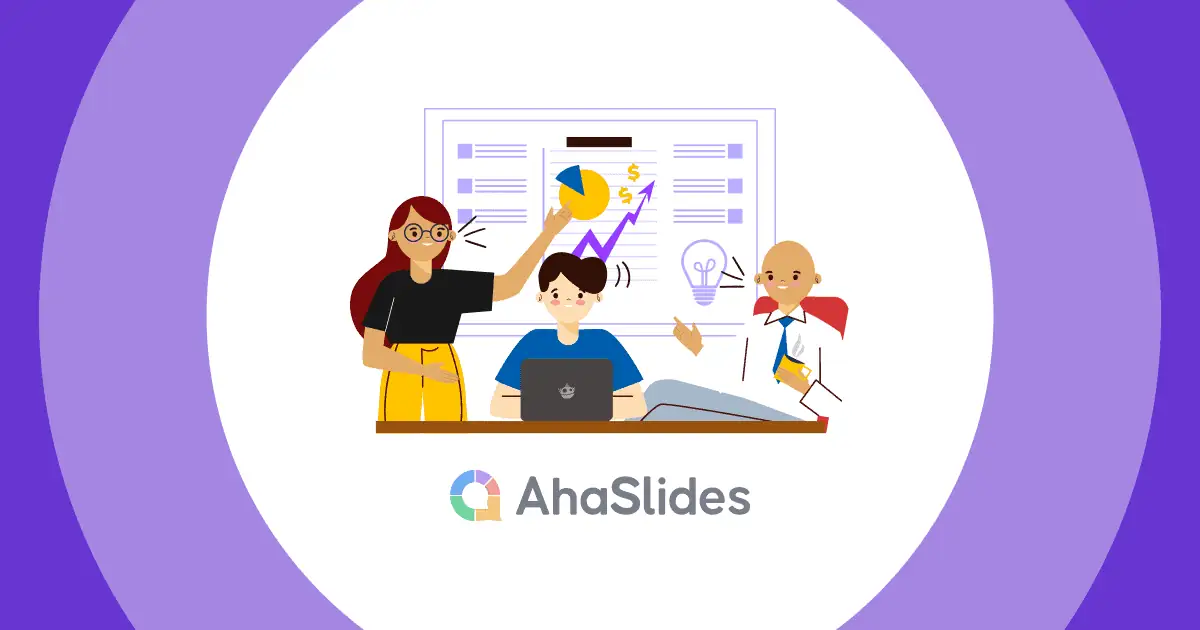Looking for strategies for motivating employees and increasing productivity? Employee motivation is crucial for the success of any organization. A motivated workforce helps increase productivity, job satisfaction, and employee retention. However, motivating employees is not always easy, and it requires a strategic approach.
Let's explore effective employee motivation strategies. Whether you are a manager or an HR professional, these strategies will provide you with practical insights and actionable tips to inspire and engage your employees.
Table of Contents
- Overview
- What Is Employee Motivation?
- Importance of Employee Motivation Strategies
- 8 Effective Employee Motivation Strategies
- Key Takeaways
- Frequently Asked Questions
Tips for Better Engagement

Looking for a tool to engage your team?
Gather your team members by a fun quiz on AhaSlides. Sign up to take free quiz from AhaSlides template library!
🚀 Grab Free Quiz☁️
Overview
| What are the 3 major approaches to employee motivation? | Maslow's hierarchy of needs, McClelland's need theory, and Herzberg's two-factor theory. |
| What are the 4 steps to motivating employees? | Set clear expectations, recognize and praise regularly, help them understand the big picture, and foster a compassionate company culture. |
What Is Employee Motivation?
Employee motivation includes various factors that influence an employee's behavior, effort, and commitment to achieving the organization's goals.
Motivated employees are enthusiastic, engaged, and committed to their work, and they are more likely to perform at a high level and contribute to the organization's success.

It's important to note that motivation is not a fixed trait, and employees can experience varying levels of motivation depending on different factors, such as their personal circumstances, work environment, and job responsibilities.
So, employers can play a role in creating an environment that fosters high motivation and engagement among their employees by providing meaningful work, opportunities for growth and development, recognition and rewards, and supportive and positive work culture.
Importance of Employee Motivation Strategies
Employee Motivational Strategies are essential for several reasons, including:
1/ Increase Employee Engagement
Motivation strategies can help employees feel more engaged in their work, leading to higher levels of job satisfaction and commitment to the organization.
2/ Improve Productivity
When employees are motivated, they are more likely to be proactive in seeking ways to improve their performance, take on new challenges, and exceed expectations.
They may be more willing to go above and beyond their duties and more likely to take ownership of their work. It can lead to improved performance and increased productivity.
3/ Reduce Turnover Rate
High employee turnover can be costly for organizations, such as increased recruitment and training costs, lost productivity, and lower morale.
By implementing effective employee motivation strategies, organizations can create a positive work environment that fosters growth and development, which can improve employee retention rates.

4/ Enhanced Creativity And Innovation
Employee motivation strategies can encourage employees to be more creative and innovative in their work, leading to new ideas and approaches that can benefit the organization.
5/ Better Collaboration And Teamwork
Motivated employees may be more willing to share their ideas and collaborate with others to achieve common goals. They may be more open to feedback and constructive criticism, which can help to improve communication and trust within the team.
And they are more willing to support and help their teammates, which can contribute to a positive team culture.
6/ Increase Profitability
Effective employee motivation strategies can contribute to increased profitability for the organization in several ways.
- It improves employee performance, such as increasing sales, improving customer satisfaction, and enhancing the organization's reputation in the marketplace.
- It helps employees come up with new ideas and approaches that can benefit the organization to stay competitive in the market.
- It helps reduce turnovers and associated costs such as recruitment and training.
- It creates a positive work culture and helps to improve the organization's reputation, attracting top talent and reducing recruitment costs.

Effective Employee Motivation Strategies
Here is a step-by-step guide that helps you to implement effective employee motivation strategies:
1/ Identify the needs of your employees
Identifying the needs of your employees is a crucial step in creating effective employee motivation strategies. It involves understanding what motivates your employees and what challenges they face in the workplace. Conducting surveys, focus groups, or one-on-one meetings with employees can help to gather this information.
- Surveys with polls and Q&A. They can be useful tools for collecting anonymous feedback from employees. You can conduct a survey online with a range of topics such as job satisfaction, work-life balance, opportunities for growth and development, and recognition and rewards.
- Focus groups. These group sessions involve a small number of employees and are facilitated by a trained moderator. They can provide a more in-depth understanding of employees' needs and identify common themes or concerns.
- One-on-one meetings. These meetings can provide a safe space for employees to discuss any issues or challenges they may be facing and can help to build trust with managers or supervisors.
By understanding the needs of your employees, you can create tailored motivation strategies that address their specific challenges and concerns.
- For example, if employees report feeling stressed or overwhelmed, you may want to consider offering additional support or resources such as counseling services or wellness programs.
2/ Define clear and measurable goals
Clear goals and expectations help employees understand what they are working towards and how their work contributes to the organization's mission and objectives.
To define clear and measurable goals, it's important to:
- Set specific targets for performance that can be tracked and measured over time. These targets should be achievable and realistic yet still challenging enough to motivate employees to strive for excellence. For example, if an employee is responsible for sales, their goals could include achieving a certain level of sales each month or quarter.
- Ensure that employees understand what is expected of them. You can set up regular one-on-one meetings with employees to discuss their progress and what needs to improve.
- Provide regular feedback. It is a critical component of this step, as it allows employees to track their performance and make adjustments if necessary. Feedback can be performance reviews or more informal check-ins.

3/ Provide opportunities for growth and development
Organizations can provide these opportunities by offering training, coaching, and mentorship programs. These programs can help employees develop new skills and knowledge, which can benefit both the employee and the organization.
- For example, an employee who receives training in a new technology or process may be able to work more efficiently, leading to improved productivity and results.
Besides, these programs help employees feel valued and supported, leading to greater engagement and motivation.
- For example, an employee who has the opportunity to lead a project may feel pride in their work, leading to increased motivation and productivity.
4/ Recognize and reward performance
When employees feel that their contributions are valued and appreciated, they are more likely to be motivated and engaged in their work.
Recognition and rewards can take many forms, from public praise to bonuses, rewards, or promotions.
- For example, a bonus could be given to an employee who meets or exceeds a specific performance target, or a promotion could be offered to an employee who consistently demonstrates leadership in their task.
However, rewards and recognition should be tied to meaningful achievements or behaviors, rather than just being given arbitrarily. This ensures that employees feel that their efforts are truly appreciated and that there is a clear connection between their actions and the rewards they receive.
5/ Create a positive work environment
A positive work environment is one that is supportive, inclusive, and enjoyable. This environment can be created by:
- Encouraging collaboration and teamwork. When employees feel that they are working together toward a common goal, they are more likely to be motivated to succeed.
- Providing opportunities for social interaction, such as team-building activities or company events, can also help to create a sense of community and support among employees.
- Creating a culture of respect and trust. This can be achieved by encouraging open communication and feedback, recognizing and rewarding positive behaviors, and addressing any workplace issues promptly and effectively.

6/ Offer work-life balance
By prioritizing work-life balance, organizations can create a healthier workplace culture and reap the benefits of a more engaged and productive workforce.
Providing flexible work arrangements such as telecommuting, flexible schedules, or additional time off can help employees balance their personal and professional commitments. This can lead to reduced stress, improved employee satisfaction, higher levels of motivation and productivity, and cost savings.
- For example, allowing employees to work from home can reduce office space requirements and overhead costs.
However, it's important to note that offering work-life balance should not be seen as a perk or an afterthought. It should be a fundamental aspect of a healthy workplace culture that promotes employee well-being and engagement.
7/ Communicate effectively
Here are some details about effective communication as an employee motivation strategy:
- Be Transparent: Being transparent about company goals and expectations can make employees feel that they are valued and an essential part of the organization.
- Encourage two-way communication: By providing opportunities for employees to voice their opinions, they feel empowered, and it also helps the organization identify issues and concerns that need to be addressed.
- Use different communication channels: Different employees prefer different communication methods, and by providing different options, you can ensure that everyone is informed and engaged.
- Keep informed about organizational changes: It helps to reduce uncertainty and anxiety in the workplace. Employees want to feel involved in the organization's direction and decisions, especially if those decisions will impact their work.
- Active listening. Listening to employees' needs can help to improve employee engagement, satisfaction, and motivation. It also allows you to address issues before they become major problems.
8/ Continuously evaluate and adapt
By continuously evaluating and adapting employee motivation strategies, organizations can ensure that they remain effective and aligned with the needs of their employees.
This can help create a more engaged and productive workforce, improving organizational performance and success.
Key Takeaways
Organizations can create a positive work environment that supports employee well-being, engagement, and performance by implementing these effective employee motivation strategies. This, in turn, can lead to a range of benefits, including higher job satisfaction, reduced turnover rates, and improved overall organizational success.
And don't miss the chance to use AhaSlides templates to inspire, motivate and effectively convey your message to your employees!
Frequently Asked Questions
How do you improve employee motivation?
Improving employee motivation is crucial for enhancing productivity, job satisfaction, and overall organizational success., with few strategies include clear and meaningful goals, effective communication, providing recognition and rewards, offering to help with professional development, empowerment, creating a supportive work environment and provide regular feedback and performance management.
Why is employee motivation important?
Employee motivation is crucial for the success and well-being of both individual employees and the organization as a whole, as it helps to increase productivity, job satisfaction, employee engagement, better problem-solving and creativity and bring out a positive organizational culture.
What are the major approaches to employee motivation?
Major approaches can be identified in Maslow's hierarchy of needs, Herzberg's two-factor theory and McClelland's theory of needs. Also, you can learn more about process theories of motivation to focus on the cognitive processes and decision-making involved in motivation.








